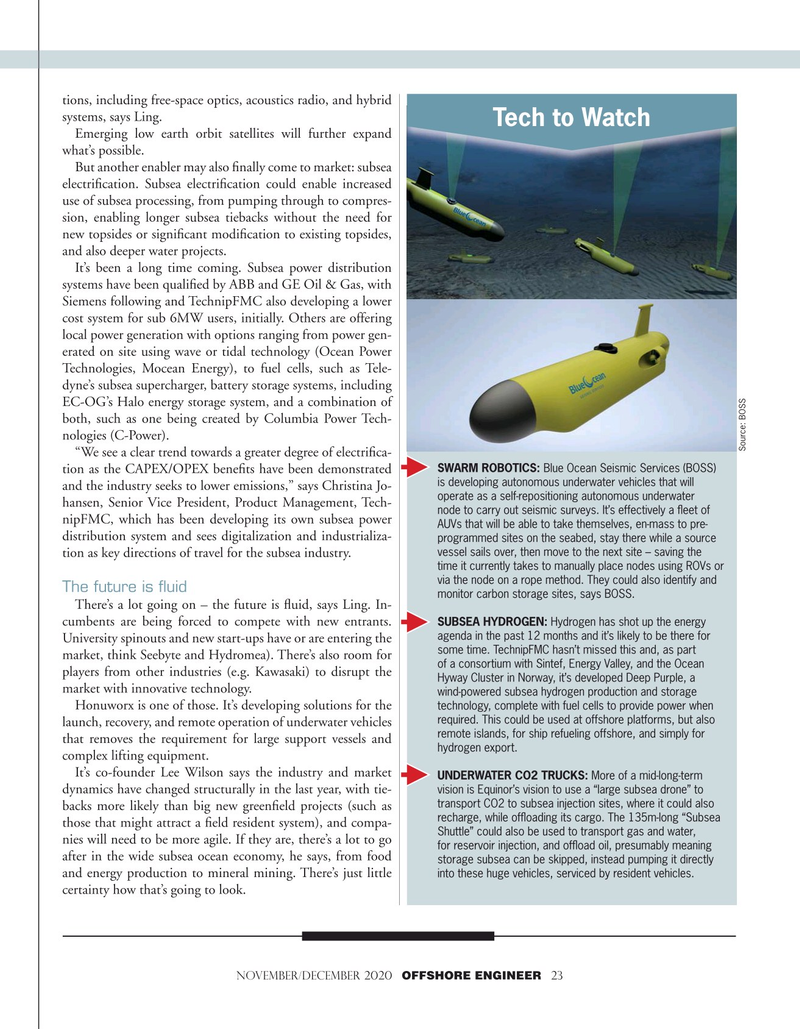
Page 23: of Offshore Engineer Magazine (Nov/Dec 2020)
Read this page in Pdf, Flash or Html5 edition of Nov/Dec 2020 Offshore Engineer Magazine
tions, including free-space optics, acoustics radio, and hybrid systems, says Ling.
Tech to Watch
Emerging low earth orbit satellites will further expand what’s possible.
But another enabler may also ?nally come to market: subsea electri?cation. Subsea electri?cation could enable increased use of subsea processing, from pumping through to compres- sion, enabling longer subsea tiebacks without the need for new topsides or signi?cant modi?cation to existing topsides, and also deeper water projects.
It’s been a long time coming. Subsea power distribution systems have been quali?ed by ABB and GE Oil & Gas, with
Siemens following and TechnipFMC also developing a lower cost system for sub 6MW users, initially. Others are offering local power generation with options ranging from power gen- erated on site using wave or tidal technology (Ocean Power
Technologies, Mocean Energy), to fuel cells, such as Tele- dyne’s subsea supercharger, battery storage systems, including
EC-OG’s Halo energy storage system, and a combination of both, such as one being created by Columbia Power Tech- nologies (C-Power).
Source: BOSS “We see a clear trend towards a greater degree of electri?ca-
SWARM ROBOTICS: Blue Ocean Seismic Services (BOSS) tion as the CAPEX/OPEX bene?ts have been demonstrated is developing autonomous underwater vehicles that will and the industry seeks to lower emissions,” says Christina Jo- operate as a self-repositioning autonomous underwater hansen, Senior Vice President, Product Management, Tech- node to carry out seismic surveys. It’s effectively a ?eet of nipFMC, which has been developing its own subsea power
AUVs that will be able to take themselves, en-mass to pre- distribution system and sees digitalization and industrializa- programmed sites on the seabed, stay there while a source vessel sails over, then move to the next site – saving the tion as key directions of travel for the subsea industry. time it currently takes to manually place nodes using ROVs or via the node on a rope method. They could also identify and
The future is fluid monitor carbon storage sites, says BOSS.
There’s a lot going on – the future is ?uid, says Ling. In- cumbents are being forced to compete with new entrants.
SUBSEA HYDROGEN: Hydrogen has shot up the energy agenda in the past 12 months and it’s likely to be there for
University spinouts and new start-ups have or are entering the some time. TechnipFMC hasn’t missed this and, as part market, think Seebyte and Hydromea). There’s also room for of a consortium with Sintef, Energy Valley, and the Ocean players from other industries (e.g. Kawasaki) to disrupt the
Hyway Cluster in Norway, it’s developed Deep Purple, a market with innovative technology. wind-powered subsea hydrogen production and storage
Honuworx is one of those. It’s developing solutions for the technology, complete with fuel cells to provide power when required. This could be used at offshore platforms, but also launch, recovery, and remote operation of underwater vehicles remote islands, for ship refueling offshore, and simply for that removes the requirement for large support vessels and hydrogen export. complex lifting equipment.
It’s co-founder Lee Wilson says the industry and market
UNDERWATER CO2 TRUCKS: More of a mid-long-term dynamics have changed structurally in the last year, with tie- vision is Equinor’s vision to use a “large subsea drone” to transport CO2 to subsea injection sites, where it could also backs more likely than big new green?eld projects (such as recharge, while of?oading its cargo. The 135m-long “Subsea those that might attract a ?eld resident system), and compa-
Shuttle” could also be used to transport gas and water, nies will need to be more agile. If they are, there’s a lot to go for reservoir injection, and of?oad oil, presumably meaning after in the wide subsea ocean economy, he says, from food storage subsea can be skipped, instead pumping it directly and energy production to mineral mining. There’s just little into these huge vehicles, serviced by resident vehicles.
certainty how that’s going to look.
November/December 2020 OFFSHORE ENGINEER 23

 22
22

 24
24